The Island Odyssey: A Weeklong Adventure in Rhodes
Exploring Ancient Ruins, Sandy Beaches, and Hidden Gems in the Heart of the Aegean
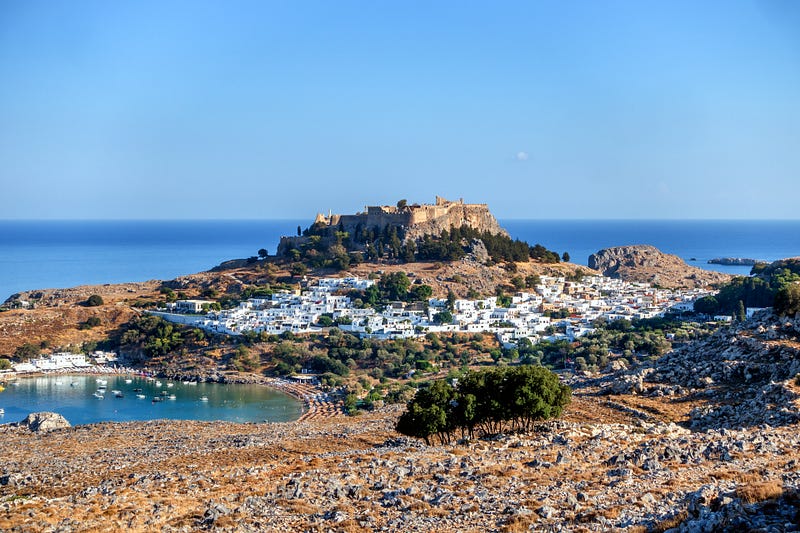
I wouldn’t have thought that at the end of September, we would have the opportunity for another vacation. Thanks to my mother, we traveled to Rhodes for a week.
I have been to Greece several times, during which I had the opportunity to visit the usual tourist attractions, such as the Acropolis of Athens or the Meteora, but I had only been to Mykonos among the many Greek islands before.
So, with the anticipation of something new, we embarked on this early autumn journey.
Preparation and Arrival
Usually, before my trips, I spend long evenings planning what is worth visiting in the given location and organizing how to achieve these plans. But, this time it didn’t happen that way; I only arranged the car rental in advance online. I thought I would figure out the visitation of all the major sights and solve it on the spot.
I was surprised to find that in Rhodes, there are many small car rental companies, and with these companies, there is no need for a deposit. Moreover, the price already includes full insurance. At first, I thought it was some kind of scam, but later I was surprised by the service provider, who also brought the rented car to the hotel and took it from there.
So, on a Tuesday afternoon, we arrived on the island of Rhodes with a half-empty Aegean direct flight to begin our week-long stay.
Our Accommodation in Faliraki
After about a half-hour bus ride, we arrived at our accommodation in the holiday resort of Faliraki. The accommodation was simple and clean, with all-inclusive service.
Generally, as an experienced traveler and a vegetarian, I usually opt for breakfast only at the accommodation, as I prefer to handle my meals myself, but this time this trip was a gift from my Mom, so the full service came with the package.

So, Faliraki is a seaside resort town with both upscale and simpler accommodations, as well as a main street filled with tourist traps.
The bay along the seashore, which included a several-kilometer-long stretch of clean sandy beach, enticed us to witness the sunrise, which occurred around 7 a.m. every morning due to its eastern orientation. On one of these mornings, I took a photo of the sunrise, as shown in the photograph above.
Lindos
The day after our arrival, the rented car was delivered to our accommodation, and after a quick administration, it was clear where our first-day trip would lead. We chose to visit the ancient ruins of Lindos, a choice we did not regret at all.
Located about a 45-minute drive from Faliraki, the ancient city welcomed us with a breathtaking view from the parking lot, where diligent young parking attendants quickly relieved us of a few euros.
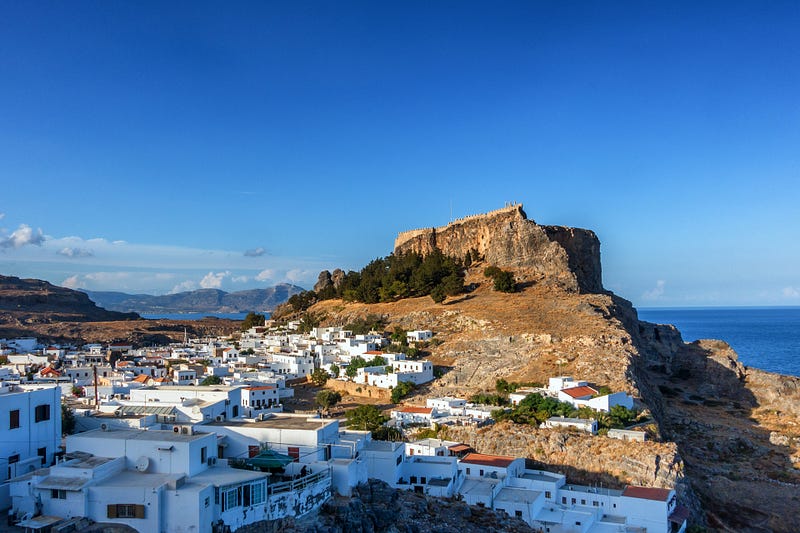
The ancient ruins of the city are situated on a cliff, at the foot of which lies the new district filled with snow-white houses, almost exclusively housing souvenir shops and bars.
Unfortunately, passing by these is mandatory since the only way to approach the fortress on the hilltop is through the new district. Relying on Google Maps, we left behind the hustle and bustle of souvenir shops and bars and were already on the steep path toward the entrance of the Acropolis.
The entrance fee was 12 euros, which was worth the price!
About this outstanding historical landmark
Lindos was founded by the Dorians in the 10th century BC. It was one of the six cities known as the Dorian Hexapolis. Due to its eastern location, Rhodes became a meeting place for Greeks and Phoenicians, and Lindos, in turn, evolved into a significant trading city.
In classical times, the Acropolis of Lindos was dominated by the colossal temple of Athena, which likely reached its final form around 300 BC. During the Hellenistic and Roman periods, more buildings were added around it, but they fell into disuse in the early Middle Ages.
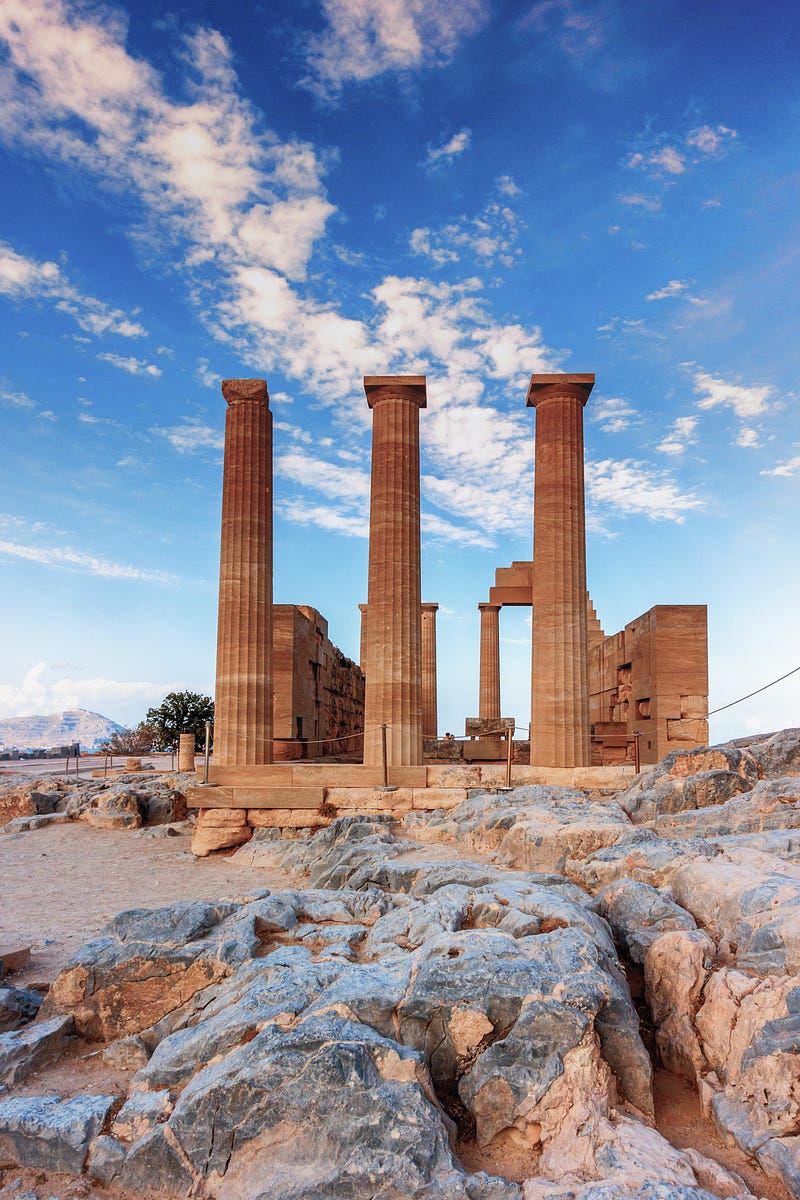
In the 14th century, the Knights of Saint John (Knights Hospitaller) fortified the Acropolis with a castle to protect the island from the Ottomans.
Need to highlight the remains of a Rhodian ship carved into the rock wall at the entrance of the Acropolis, dating back to the second century BC.
The Acropolis offers a marvelous view of St. Paul’s Bay. It is claimed that St. Paul landed here in the year 51 AD to preach Christianity to the Rhodians.
The small church built on the hillside is a popular wedding location, most likely because of the beautiful views of the bay and Lindos Acropolis. During our visit, two English couples were getting married.
Lindos can be reached by bus and boat from almost any point on the island.
Prasonisi
On the following day, at my mother’s request, who had already been to the island of Rhodes for the third time, we visited its southernmost point, where the Aegean Sea and the Mediterranean Sea meet. So, Prasonisi Cape is located in the southern part of the island and is reachable with about a one-hour drive from the resort town of Faliraki.
Upon our arrival, we left the rented car in the free parking lot right by the shore and immediately headed towards the Mediterranean coastline, which was more appealing to us due to its faint turquoise shade. By contrast, the Aegean Sea was dark blue.
The water was crystal clear, and the sandy coastline provided a great opportunity for a short rest. The wind was blowing quite strong, making this stretch of coast a paradise for surfers and kiteboarders.

After having enough relaxation with my wife, we decided to explore Prasonisi Island, connected to the mainland by a sandy strip. Fortunately, it was low tide, allowing us to approach the southernmost small island on dry land.
The goal of our walking tour was the lighthouse located at the southernmost point of the island. During our one-and-a-half-hour walk, we were led on barren paths, up and down our way, even though Prasonisi means ‘green island’ in Greek.
I can only recommend this short walk to everyone, depending on the weather, as the view speaks for itself, as confirmed by the photos.

Following the short walk, my wife and I joined my mother and aunt, who had been sunbathing on the shore, and then we returned to Faliraki with our rented car.
It was sad to see during the journey how the forest fires caused by the summer heat had ravaged the eastern side of the island. There were no fires during our stay, but the visible traces saddened us.
However, it was good to see that in the weeks following the fires, serious efforts were underway by the locals to replant the vegetation.
Kameiros Ruins and Holy Monastery of the Virgin Mary Tsambika
The next day, my wife and I continued our adventures as my mother and aunt decided to stay back at the hotel to rest.
The daily itinerary quickly took shape, consisting of a visit to the ruins of Kameiros and a monastery located on a hill. Since Kameiros is situated on the western coast of the island, we had to crisscross the island with our rented car, passing through various places and hills. The view of the mountainous terrain itself was worth the effort.
Kameiros, together with Lindos and Ialyssos, was one of the three city-states founded by the Dorians who settled in Rhodes, according to Homer.
The exploration of the ancient city’s ruins was a refreshing program, especially due to the panoramic view from the remains of the Athena temple located at the top of the city.
In my opinion, the 6 EUR entrance fee was reasonable, and it was an interesting program for the morning.
Several stone blocks with ancient Greek inscriptions were displayed, and I was pleased to find that Google Translate successfully translated some of these.
Our next stop was the Tsambika Monastery on the other side of the island, built on top of a hill with a gorgeous view of the sea and the surrounding area, offering breathtaking views over the beaches of Tsambika and Kolymbia.
From the parking lot, 350 steps lead up to the monastery, which can be challenging for the less physically fit, but the wonderful view will undoubtedly compensate for the effort of every visitor. The view from the 240-meter height speaks for itself, as well confirmed by the attached picture.
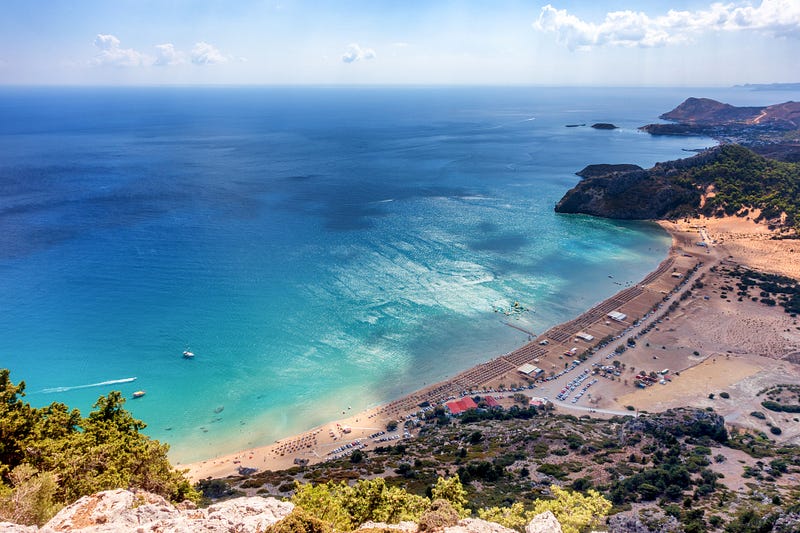
Upon returning to our accommodation, we decided to revisit the Tsambika beach, this time accompanied by my mother and aunt. We spent the late afternoon until sunset on the beautiful sandy beach, where, in addition to many beach clubs, there was plenty of space for tourists who prefer the free beach. Parking at the beach was also free.
The Old City of Rhodos
As we rented a car for only three days, for our next day trip, we opted for local transportation. From Faliraki, several buses depart to the capital of the island, Rhodes. Although the bus stops at many places, almost at every hotel, it takes only 25–30 minutes to reach the Old Town for 2.5 EUR.
During the rule of the Hospitaller Knights, who arrived from the Holy Land in the Middle Ages, the island developed significantly. The distinctive character of the city center of Rhodes, protected by UNESCO World Heritage, was shaped by Catholic knights from various European countries. After the Turks occupied the city of Rhodes, the Hospitaller Knights moved their headquarters to the distant island of Malta.
So, our first and most important destination was the Grand Master Palace, a medieval castle in the city center. It is one of the few examples of Gothic architecture in Greece. It is a marvelous architectural masterpiece that is worth the 8 EUR entrance fee.
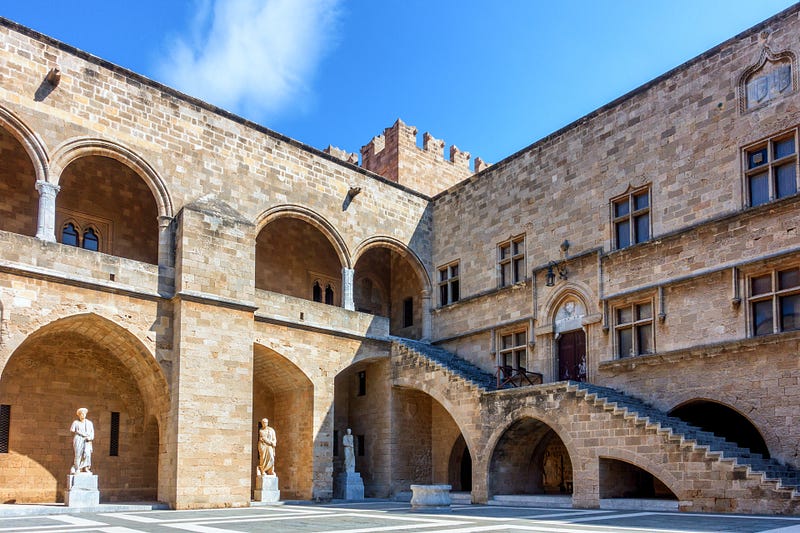
After visiting the palace, we walked along the Street of the Knights, then, passing through one of the city wall gates, found ourselves in the harbor.
You can spend a lot of time in the Old Town of Rhodes, but as we got hungry from exploring the many attractions, we entered a restaurant to taste authentic Greek delicacies. Our stroll concluded with an ice cream, after which we returned to our accommodation in Faliraki from the central bus station.
Final Thoughts
The week spent on the island of Rhodes was a pleasant surprise. The fantastic late summer weather, a rich history, and a wide variety of sandy beaches were captivating.
At my wife’s request, I need to mention that there are many goats and cats on the island.
I can only recommend visiting the island, not only for those who enjoy seaside vacations but also for those who love excursions and hiking.
Please check out my other writings related to travel.
Hello, I’m Jozsef. I’m writing about spirituality, traveling, and generative AI. To see my stories pop up on your feed, I’d love for you to follow me (Jozsef Kovacs). And, to have stories sent directly to you, subscribe to my newsletter.👇






